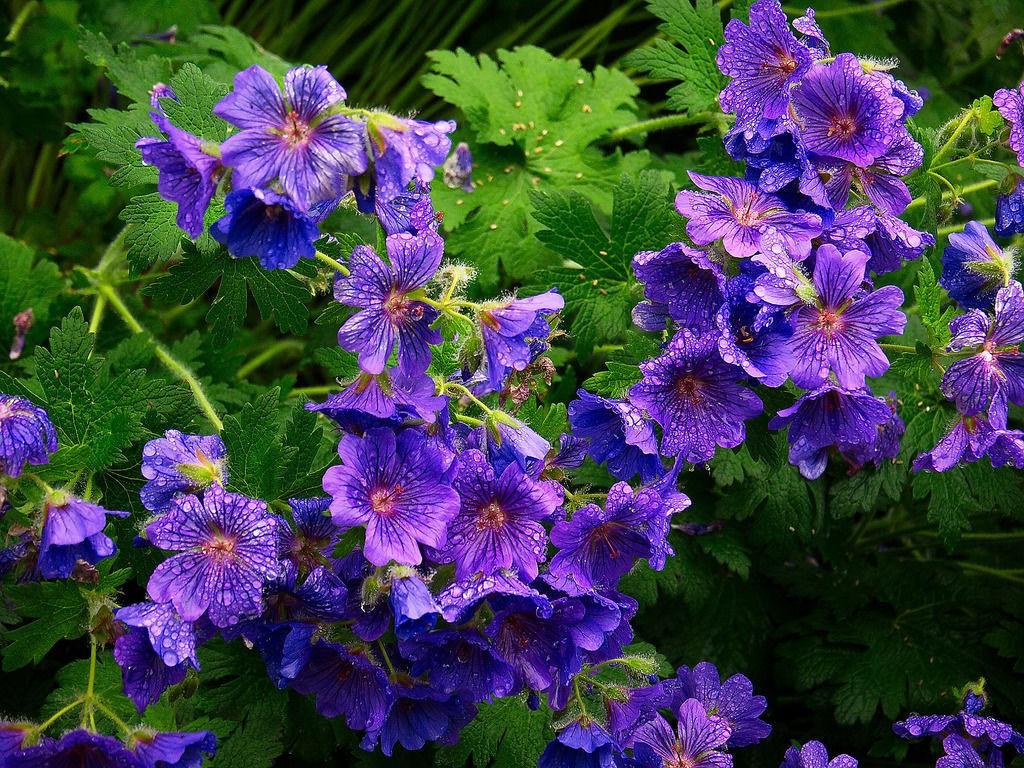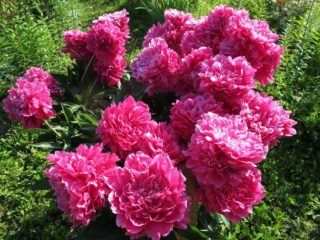Content
Magnificent geranium is a perennial that has spread throughout all regions of Russia, the countries of Europe and Asia. The plant remains viable for 15 years without replanting. It does not need attention and can grow in any soil.
History of origin
The name of the originator remains unknown, since the magnificent geranium appeared in the 17th century. At this time, the nobility began to use culture to decorate their possessions. The species was obtained as a result of hybridization. Parent varieties – “Gruzinskaya”, “Ploskolepestnaya”.
Description of the magnificent geranium
Geranium is a large genus with more than 400 varieties. One of them was the magnificent geranium, found in different parts of the planet. The species has many similarities with related plants.

Favorable conditions for the propagation of magnificent geranium are alkaline or slightly acidic soil.
The culture is suitable for growing in open, closed, sunny, shady areas. Magnificent geranium looks beautiful in flower beds and takes root well at home and in the wild.
The culture can be found in America, China, Japan, Russia, Canada, Czech Republic, Austria, Germany, France.It is used for decorative purposes. Parks, alleys, and country houses are often decorated with plants. Landscape designers use it to create compositions with roses, lilies of the valley, and shrubs.
Magnificent geranium is in many ways reminiscent of pelargonium. However, the blooms are not so picturesque. Several years ago, scientists classified them as one species, and then separated them. The Latin name for pelargonium is “Geranium”. If you translate it, you get the word “Geranium”.
In dictionaries you can find the roots from which “Geranium” came. The first mentions were recorded in Greece, where the plant was called "Geranos". Then borrowing began, and the species came to Europe. In Greek the word means "Crane". The plant received this name due to the resemblance of the seeds to a bird.
The leaves of the magnificent geranium are collected in a rosette. The plates are located singly, opposite each other, and have a dissected – often lobed – shape. The petioles are clearly visible. By autumn the foliage turns reddish.

Magnificent geranium can grow even in sandy soil, but swampy soil is destructive for it
Depending on the variety and growing conditions, the diameter of the bud may vary. The average size is 40-50 mm. They grow in groups; single specimens are rare. The flowers consist of five petals located at a short distance from each other. They are purple or blue in color, with dark wavy lines visible on the surface.
The upper part of the sepals has a pointed point; some varieties have blunt ends. The middle of the flower is decorated with a pistil that stands out against the background of the petals. On the filaments one can distinguish a fluff around which 10 stamens are collected.The buds are on stalks; up to several dozen are formed on one plant. The quantity compensates for the small size of the flower.
The fruits contain seeds that look like a crane's beak. The fruits burst, dispersing the seeds in the wind. They have microscopic hooks that allow them to cling to the skin of animals. The latter - like the wind - are carriers.
The best varieties with photos
Magnificent geranium includes the following varieties:
- Blue Blood - bushy structure, rounded shape. This low-growing variety reaches no more than 30 cm. Blue petals with dark patterns make up a 4-centimeter flower.
The plant loves light areas more than others
- Alan Mayes (Alan Mayes) grows to 38-42 cm, from the side it resembles a sphere. The buds are blue in color, with contrasting veins along the perimeter.
When choosing a magnificent geranium, most gardeners choose this variety
- Rosemoor (Rosemoor) is a medium-sized bush, height can exceed 47 cm, width - 39 cm. Purple and lapis lazuli shades are mixed in a single color of the petals. The average flower diameter is 5.5 cm.
The bush is actively grown in Sweden and Germany
- Mrs Kendall Clark (Mrs. Kendall Clark) is a variety characterized by rapid growth. Height is about 60-65 cm. Socv
With a lack of light, magnificent geranium flowers may droop
Advantages and disadvantages
Magnificent geranium is distinguished by its germination. The ornamental plant is used to decorate public areas.

Geranium is magnificent, compact, well suited for indoor growing
Pros:
- grows in any soil;
- not picky about lighting;
- needs a minimum amount of fertilizing;
- blooms profusely.
Minuses:
- small bud diameter.
Planting magnificent geranium
For 1 sq. m can accommodate up to 10-15 seedlings. Planting is done in a pot; as the weather gets warmer (usually in May), the crop is transferred to open ground. The soil is dug up; if it is not fertile, fertilizers are added. Other plants should not interfere; weeds should be weeded out.
Caring for magnificent geraniums
Geranium splendid is ideal for beginners. The plant requires a minimum of care. Each variety is resistant to drought, diseases and pests. Humidity requirements may vary. Compost is used as organic fertilizer. To improve flowering, feed with phosphorus.
Don’t forget about cutting, because the number of buds depends on it. Withered flowers are carefully removed. In the spring, the bush is re-inspected for deformations, the injured areas are cut off with a sharp (disinfected) instrument. For intensive planting, use a brush cutter. Some varieties bloom again.

Fertilizers are applied in accordance with the dosages on the package, otherwise they may harm the plant
Magnificent geranium is suitable for cultivation in Russia. It has good winter hardiness; in temperate latitudes it needs a small shelter made of spruce branches or agrofibre. If the winter is snowy, the plant can overwinter under a layer of snow.
Diseases and pests
If you do not control the frequency of watering and do not loosen the soil, the magnificent geranium will become infected with fungus. In case of damage, fungicides are used. The drugs are used in accordance with the instructions.
Although the culture has a strong immune system, poor handling can cause the following diseases:
- rust;
- bacterial spot;
- downy mildew.
The bushes are inspected daily, otherwise they may be taken over by pests. Among the latter, dangerous for magnificent geranium are:
- spider mite;
- sawfly;
- chrysanthemum nematode.
Reproduction methods
Magnificent geranium is propagated in two ways - by division or seeds. Some varieties are propagated using cuttings.
A novice gardener should grow a bush by division. To do this, dig up part of the roots and separate a small piece from them. The shovel is deepened carefully, since healthy roots can be damaged in the process. The procedure is carried out in the last months of spring.

A month after planting, magnificent geranium can be fed with minerals
Those who want to grow magnificent geranium from seed need to be patient - the process takes several years. Seeds germinate slowly and do not always produce results. In summer, planting material is dried and placed in a refrigerator or cellar.
If you have already managed to root a magnificent geranium on the site, it will reproduce itself. To do this, it is enough to take care of the plant itself. But if it is necessary to prevent growth, the bushes are pruned before the fruits form.
Conclusion
Magnificent geranium is a species that deserves special attention. This is an ornamental bush grown in most Russian regions. It has good winter hardiness and strong immunity.The culture is great for beginners; due to its unpretentiousness, even experienced gardeners do not want to part with it.












